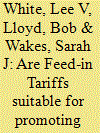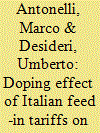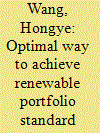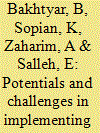|
|
|
Sort Order |
|
|
|
Items / Page
|
|
|
|
|
|
|
| Srl | Item |
| 1 |
ID:
124221


|
|
|
|
|
| Publication |
2013.
|
| Summary/Abstract |
Feed-in Tariffs (FITs) implemented by city councils in the USA have proven an effective means of stimulating installation of renewable-electricity generation capacity at a local level, and may also be effective for New Zealand cities. Though New Zealand has a high proportion of electricity generated renewably, this is mostly from centralized hydroelectricity plants. The suitability of city-level FITs for promoting solar photovoltaic panels in New Zealand is examined. Findings suggest that FITs, with rates obtained using the cost-of-generation method, could be implemented in New Zealand cities at rates comparable to those in successful FIT schemes internationally. The unique structure of New Zealand's liberalized electricity market, however, is likely to make financing FIT schemes at city-level more complex than the equivalent situation in the USA. Benefits of introducing such schemes will include the possibility for purchasers of solar PV systems to calculate returns on investment over the long term, and the streamlining of the grid connection process by reducing the number of authorities involved.
|
|
|
|
|
|
|
|
|
|
|
|
|
|
|
|
| 2 |
ID:
128404


|
|
|
|
|
| Publication |
2014.
|
| Summary/Abstract |
In less than six years, Italy has become one of the leading markets for PV power plants and one of the countries in the world with the largest number of installations and installed peak power. Such a quick and large growth is due to a series of feed-in tariff schemes that have been uncapped until 2012. As a matter of fact, any size or any number of PV power plants could be installed during a period of three years.
Since the feed-in tariffs are not paid by national taxes but are charged on the electricity bills, Italian energy users are now due to pay each year a surcharge of 9 billion euros on their energy bills.
This paper aims at discussing this development by highlighting the benefits but also some significant drawbacks that the application of uncontrolled feed-in tariffs has produced.
|
|
|
|
|
|
|
|
|
|
|
|
|
|
|
|
| 3 |
ID:
171478


|
|
|
|
|
| Summary/Abstract |
Renewable energy electricity, such as photovoltaic (PV) power generation, has the benefits of strengthening energy security, addressing climate change, reducing air pollution, etc., but there are some impediments to deployment of renewable energy electricity: higher costs than fossil fuels, intermittent energy production, site constraints, etc. Korea changed its renewable energy electricity support systems from feed-in tariff (FIT) to a renewable portfolio standard (RPS) in 2012. This study evaluates FIT versus RPS in terms of the time to reach grid parity for PVs. Using a learning curve model, we calculate the learning rate of PV power generation during the FIT and RPS periods. We find that the PV learning rate during the RPS period was 18.44%, much higher than that during the FIT period, −0.28%, and R2 is 0.9861 and 0.7346 in the RPS and FIT periods, respectively. Using the calculated learning rate in the RPS period, we also predict that grid parity for PVs is expected in 2025 in Korea.
|
|
|
|
|
|
|
|
|
|
|
|
|
|
|
|
| 4 |
ID:
133217


|
|
|
|
|
| Publication |
2014.
|
| Summary/Abstract |
This paper examines the debates around the Ontario×s Green Energy and Green Economy Act (GEGEA) as an energy and economic development strategy through comparative public policy and discourse analysis approaches. The evidence regarding the economic impacts of the GEGEA is found to be almost entirely based on the results of economic modeling exercises. Critics and supporters of the legislation have arrived at very different conclusions through such exercises. These outcomes are similar to those seen in other jurisdictions pursuing renewable energy initiatives, such as Feed In Tariffs (FITs), renewables obligations and portfolio standards. A discourse analysis approach is employed to examine the reasons for the different conclusions being reached over the impacts of renewable energy initiatives. Differences in modeling approaches and assumptions are found to reflect differences in ideational perspectives on the part of the modelers with respect to the appropriate roles of markets and the state and the relationship between economic development and environmental sustainability in public policy. The paper concludes with suggestions regarding the gathering and availability of information regarding economic development in the renewable energy sector, and a discussion of potential ways to strengthen future efforts to understand the economic and environmental impact of renewable energy initiatives.
|
|
|
|
|
|
|
|
|
|
|
|
|
|
|
|
| 5 |
ID:
132827


|
|
|
|
|
| Publication |
2014.
|
| Summary/Abstract |
This study challenges the implicit assumption of homogeneity in national institutional contexts made in past studies of (renewable) energy policy. We propose that institutional differences matter by focusing on several technology-specific and generic policy factors that can foster technology diffusion through private sector activity. More specifically, we explore perceptions of early adopters in emerging economy contexts using wind park project developers as an example. By applying a parsimonious method for our questionnaire as well as qualitative data we make several contributions: Methodologically, we introduce Maximum Difference Scaling to the energy policy domain. Empirically, we identify several public influences on private investment, and assess their relative importance. This leads to new insights challenging findings from industrialized economies; we identified additional institutional barriers to diffusion, hence, the requirement of a combination of technology-specific and generic policy measures.
|
|
|
|
|
|
|
|
|
|
|
|
|
|
|
|
| 6 |
ID:
176699


|
|
|
|
|
| Summary/Abstract |
An important strategy to stimulate renewable energy consumption is adherence to renewable portfolio standard (RPS), which has cost advantages over feed-in tariff (FIT). China published its provincial RPS goals in 2018 and, since then, it has been pressurizing provinces to realise the goals. This study develops a mid-to long-term optimisation model for the area served by the China Southern Power Grid Corporation (CSPGC) based on power-plan constraints and RPS goals for 2016–2030. The results indicate an optimal method for the five provinces in the CSPGC area to achieve their RPS goals based on the power-plan constraints till 2030. For electricity generation, wind power development should precede solar power development; further, hydropower development is particularly significant for the region. To facilitate electricity transmission, the construction of transmission lines between Guangdong and Yunnan should be prioritised. In electricity trading, RPS policy implementation will cause Guangdong to buy more electricity from western provinces, aiding the completion of the West–East Electricity Transfer Project. Moreover, in the CSPGC area, RPS policy implementation will not significantly affect the total electricity supply cost due to the development of low-cost hydropower in the region.
|
|
|
|
|
|
|
|
|
|
|
|
|
|
|
|
| 7 |
ID:
124345


|
|
|
|
|
| Publication |
2013.
|
| Summary/Abstract |
Located in Southeast Asia, Indonesia and the Philippines are characterized by a tropical climate and high amounts of rainfall that render their high potential for hydro-power and wind energy deployment. The volcanic geography of both countries also indicates their high geothermal potential compared with that of other countries, and their high solar radiation level makes them suitable areas to establish power plants. The present study is an archival-statistical overview of the potential generation of renewable energy in Indonesia and the Philippines and the implementation of the Feed-in-tariff (FiT) policy. This research focuses on the challenges encountered by politicians and policymakers and confirms the insufficient production of energy from wind, solar, and bio-gas sources despite the potential and the attempts to deploy FiT. Results show that the role of the government in providing support to investors is not clear in both countries. In addition, inflation rates have not been calculated. However, FiT has benefitted both countries by preventing degression during the primary years.
|
|
|
|
|
|
|
|
|
|
|
|
|
|
|
|
|
|
|
|
|